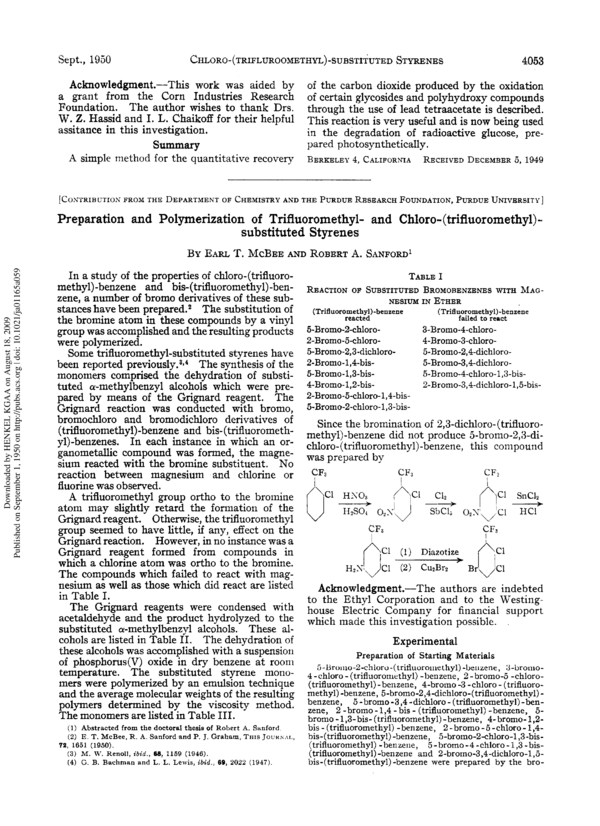Preparation and Polymerization of Trifluoromethyl- and Chloro-(trifluoromethyl)-substituted Styrenes
Preparation and Polymerization of Trifluoromethyl- and Chloro-(trifluoromethyl)-substituted Styrenes
Year:
DOI:
10.1021/ja01165a059
Type of document:
Language:
Sept., 1950
CHLORO(TRIFLUROOMETHYL)-SUBSTITUTEDSTYRENES
Acknowledgment.-This work was aided by
a grant from the Corn Industries Research
Foundation. The author wishes to thank Drs.
W. 2 Hassid and I. L. Chaikoff for their helpful
.
assitance in this investigation.
summary
A simple method for the quantitative recovery
4053
of the carbon dioxide produced by the oxidation
of certain glycosides and polyhydroxy compounds
through the use of lead tetraacetate is described.
This reaction is very useful and is now being used
in the degradation of radioactive glucose, prepared photosynthetically.
BERKELEY CALIFORNIARECEIVED
4,
DECEMBER, 1949
5
[CONTRIBLJTIOX
FROM THE DEPARTMENT CHEMISTRY AND THE PURDUE RESEARCH
OF
FOUNDATION,
PURDUE UNIVERSITY ]
Preparation and Polymerization of Trifluoromethyl- and Chloro-(trifluoromethyl)
substituted Styrenes
Downloaded by HENKEL KGAA on August 18, 2009
Published on September 1, 1950 on http://pubs.acs.org | doi: 10.1021/ja01165a059
BY EARL MCBEEAND ROBERT SANFORD~
T.
A.
In a study of the properties of chloro-(trifluoromethyl) -benzene and bis- (trifluoromethyl)-benzene, a number of bromo derivatives of these substances have been prepared.a The substitution of
the bromine atom in these compounds by a vinyl
group was accomplished and the resulting products
were polymerized.
Some trifluoromethyl-substituted styrenes have
been reported p r e v i ~ u s l y . ~ The synthesis of the
*~
monomers comprised the dehydration of substituted a-methylbenzyl alcohols which were prepared by means of the Grignard reagent. The
Grignard reaction was conducted with bromo,
bromochloro and bromodichloro derivatives of
(tdluoromethy1)-benzene and bis-(trifluoromethy1)-benzenes. In each instance in which an organometallic compound was formed, the magnesium reacted with the bromine substituent. No
reaction between magnesium and chlorine or
fluorine was observed.
A trifluoromethyl group ortho to the bromine
atom may slightly retard the formation of the
Grignard reagent. Otherwise, the trifluoromethyl
group seemed to have little, if any, effect on the
Grignard reaction. However, in no instance was a
Grignard reagent formed from compounds in
which a chlorine atom was ortho to the bromine.
The compounds which failed to react with magnesium as well as those which did react are listed
in Table I.
The Grignard reagents were condensed with
acetaldehyde and the product hydrolyzed to the
substituted a-methylbenzyl alcohols. These alcohols are listed in Table 11. The dehydration of
these alcohols was accomplished with a suspension
of phosphorus(V) oxide in dry benzene at room
temperature. The substituted styrene monomers were polymerized by an emulsion technique
and the average molecular weights of the resulting
polymers determined by the viscosity method.
The monomers are listed in Table 111.
(1) Abstracted from the doctoral thesis of Robert A. Sanford
(2) E . T. McBee, R. A. Sanford and P.J, Graham, THIS ~ J K ~ . \ I , ,
Jo
72, 1661 (1950).
(3) M. W. Renoll, i b i d . , 88, 1159 (1946).
(4) G. B. Bachman and L. L. Lewis, ibid., 69, 2022 (1947).
TABLE
I
REACTION SUBSTITUTED
OF
BROMOBENZENES MAGWITH
NESIUM IN ETHER
(Trifluoromethy1)-benzene
(Trifluoromethy1)-benzene
failed to react
reacted
5-Bromo-2-chloro2-Bromo-5-chloro5-Bromo-2,3-dichloro2-Bromo-l,4-bis5-Bromo-l,3-bis4-Bromo-l,2-bis-
3-Bromo-4-chloro4-Bromo-3-chloro5-Bromo-2,4-dichloro5-Bromo-3,4-dichloro5-Bromo-4-chloro-1,3-bis2-Bromo-3,4-dichloro-l,5-bis-
2-Bromo-5-chloro-l,4-bis5-Bromo-2-chloro-l,3-bis-
Since the bromination of 2,3-dichloro-(triiluoromethyl)-benzene did not produce 5-brorno-2,3-dichloro-(trifluorornethy1)-benzene, this compound
was prepared by
CF3
CF,
CFa
CFJ
Acknowledgment.-The authors are indebted
to the Ethyl Corporation and to the Westinghouse Electric Company for financial support
which made this investigation possible.
Experimental
Preparation of Starting Materials
~-Brotiio-2-chloro-(tri~uoroi11ethyl)-Lenzene,
8-bromo-
4 -chloro - (trifluoronirthyl) -benzene, 2 - bromo-5 -chloro(trifluoromethyl) - benzene, 4-bromo -3 -chloro - (trifluoromethyl) -benzene, 5-bromo-2,4-dichloro-( trifluoromethyl) benzene, 5 -bromo -3,4 -dichloro - (trifluoromethyl) -benzene, 2 -bromo - 1,4 - bis (trifluoromethyl) -benzene, 5bromo -1,a-bis- (trifluoromethy1)-benzene, 4-bromo-1,2bis - (trifluoromethyl) -benzene, 2 -bromo - 5 -chloro 1,4his-(trifluoromethyl) -benzene, 5-bromo-2-chloro-l,3-bis(trifluoromethyl) -benzene, 5-bromo-4-chloro-l,3 -bis(frifluoromethyl) -benzene and 2-bromo-3,4-dichloro-l,5bis-(trifluoromethyl) -benzene were prepared by the bro-
-
-
BARL MCBEEAND ROBERT SANFORD
T.
A.
40.54
Vol. 72
TABLE
I1
SUUS? I1 UTEU ~-II[ETKIILRFVZTL-ALCOHOLS
Chlorine, 5;
Calcd
Found
Fluorine, $4
Caicd.
Found
Yieid,
Compound
L"c
4-Cl-3-CFa-CsHsO
71 5
4-Cl-3-CF3-a-CH3-CsHjO66 1
4-Cl-2-CFs-C~H80
78 s
~ , ~ - C I ~ - ~ - C F ~ - C B H (1 ~
77. A
2,5-(CF3)rCsHsO
79 (i
3,5-(CF3)~-CsHs0
7
Coments go here:
- Log in to post comments

